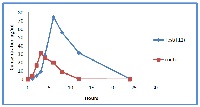Formulation and evaluation of bilayered tablets of montelukast and levocetrizine dihydrochloride Using natural and synthetic polymers
Keywords:
Tamarind Seed Polysacharide, Hydroxypropyl methyl cellulose, Bilayered tabletsAbstract
The objective of present work was to formulate and evaluate bilayered tablets of Levocetrzine and Montelukast for treating allergic rhinitis effectively. Anti-allergic medicines (eg, some antihistamines) can cause adverse events such as somnolence and sedation. The Combining Montelukast with Levocetirizine gives additional benefits in comparison with either drug alone and could be considered for patients whose quality of life is impaired by persistent allergic rhinitis. Montelukast sodium is alkaline stable (bioavailability 64%), most of drug being absorbed from the intestine while Levocetirizine Dihydrochloride is acid stable. When tablets of the combination of these are prepared, they tend to become unstable during the shelf life of the formulation. Hence it is recommended to prepare a bilayer tablet, by formulating Montelukast in sustained release layer and Levocetrizine as immediate release layer as it improves and increases the stability by reducing the acid base interactions of both the drugs in combination there by increasing the bioavailability. Taking this into account different formulations were prepared by wet granulation method using natural Tamarind Seed Polysaccharide and synthetic HPMCK100,K15M and K4M release rate controlling hydrophilic polymers. The formulations were evaluated for hardness, weight variation, friability, swelling index and drug content uniformity. The in vitro release of drug from the formulations was studied in pH 1.2 acidic buffer and pH 7.4 phosphate buffer, and it was found that the prepared tablets were able to sustain the release of the drug upto 12hours. The release of Montelukast and Levocetrizine of both layers from the tablets was found to be diffusion controlled and the release mechanism was non-Fickian based on the n value of Korsmeyer-peppas plot. The FTIR studies were performed on three optimized formulations (F4, F12, F16) and the plain drug controls(Levocetrizine,Montelukast).From the observed peaks it is evident that the polymers used and the drugs were found to be mutually compatible chemically. The Pharmacokinetic Studies were performed in two groups of male wistar rats. One group was administered with the optimized formulation containing tamarind Seed Polysaccharide(F12) while Plain Montelukast oral suspension acted as control in the second group.The results indicate that the formulation optimised with 1:4(drug:TSP) was able to sustain the release of montelukast upto 12hours.Insrease in Tmax and AUC(0-α) also were also observed in the studies indicating efficient sustained action and improved bioavailability of the drug. The formulated bilayered tablets using natural polymers provided immediate release of Levocetrizine and sustained release of Montelukast and therefore hold promise as an alternative dosage form in the treatment of allergic rhinitis and bronchial asthma.
References
Rathod RT, Misra D, FDC of Montelukast with levocetirizine: focus on bilayer technology,
J Indian Med Assoc. 2009 ;107(10):734.
Rathod RT, Misra D; FDC of Montelukast with levocetirizine: focus on bilayer technology
Journal of the Indian Medical Association (JIMA). 2009; 107 (8); 562-4.
Jan Vogeleer ,Challenges in Developing A Bilayer Tablet , Powder technology division,Niro Pharma systems.
Patel Mehul,Ganesh Nanjan Sockan, kavitha, Tamizh Mani. Challenges in the formulation of bilayered tablets. International Journal of Pharma Research and Development, 2010; 2:23-35
R. L. Whistler ,Industrial Gums, Ed. (Academic Press, New York, 1973;2nd ed:369-411.
Indian pharmacopoeia, The Controller of publications, New Delhi, 1996;4th edition:vol II, 469.
Sameer H Lakade, "Formulation development and evaluation of mouth dissolving tablets of Ondansetron hydrochloride", Asian Journal of pharmaceutics. 200; I:150-153.
Michael E Aulton, Pharmaceutics, The Design and manufacture of medicines, Harcourt Publishers Limited, London. 2007; 3:175-177.
USP 27/NF 22, Asian edition, General test procedures, U.S. Pharmacopoeial convention, Rockville MD. 2004:1204.
Al-Taani BM, Tashtoush BM. Effect of microenvironment pH of swellable and erodable buffered matrices on the release characteristics of diclofenac sodium. AAPS PharmSciTech. 2003;4:E43.
Glicksman M. Tamarind seed gum in food hydrocolloids. Florida CRC Press.1986; 3: 191-202.
Ibrahim A. Alsarra. Development of a stability-indicating HPLC method for the determination of montelukast in tablets and human plasma and its applications to pharmacokinetic and stability studies. Saudi Pharmaceutical Journal Saudi Pharmaceutical Journal. 2004; 12: 22-33.
.Pattana Sripalakit , Bungon Kongthong, Aurasorn Saraphanchotiwitthaya. A simple bioanalytical assay for determination of montelukast in human plasma: Application to a pharmacokinetic study, Journal of Chromatography. 2008; 869: 38–44
Siepmann J, Peppas NA. Modeling of drug release from delivery systems based on hydroxypropyl methylcellulose. Advances Drug Delivery. Revised. 2001;48:139-157.
Korsmeyer RW, Gurny R, Docler E, Buri P, Peppas NA. Mechanism of solute release from porous hydrophilic polymers. Int J Pharm.1983;15:25-35.





